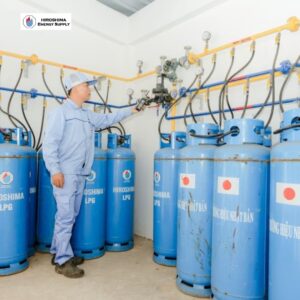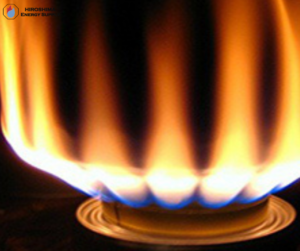- HES@hiroshima-energysupply.com
- 0919316889
Ensuring that the gas tank contains the correct amount of gas as promised not only helps you use it effectively but also ensures safety during use. Below are methods to help you check and determine the amount of gas in the tank accurately.
1. Check the Weight of the Gas Cylinder Upon Receiving the Goods
When you receive a new gas cylinder, the first thing you should do is check the overall weight of the cylinder. This weight includes the weight of the cylinder shell and the amount of gas inside. On each gas cylinder, the manufacturer usually embosses the weight of the cylinder (usually marked as “TW” or “Cylinder Weight”). To determine the actual amount of gas, you can do the following:
Weigh the total weight of the new gas cylinder.
Subtract the weight of the cylinder shell printed on the cylinder body.
The result is the actual weight of gas inside.
For example: If the weight of the cylinder shell is 13.9kg and the total weight is 25.9kg, then the amount of gas inside is: 25.9kg (total weight) – 13.9kg (shell weight) = 12kg gas.
Note that, according to regulations, the allowable loss during gas filling can be up to 200g.
2. Check the Weight of the Gas Cylinder After Use
After using up all the gas, you can weigh the cylinder again to check if there is still gas or liquid inside. If the weight of the cylinder after use deviates significantly from the specifications printed on the cylinder body, fraud may have occurred during the gas filling process.

3. Observe the Flame Color When Using
Gas quality also affects performance and safety during use. When burning, if the flame is a steady blue color, it shows that the gas is burning well. Conversely, if the flame is red or unstable, the gas may be of poor quality or running low.

4. Gently Shake the Gas Cylinder to Determine the Amount of Gas Remaining
When you suspect that the gas tank is running low, you can gently shake the tank. If the tank feels light and you don't hear any liquid moving inside, the tank may be low on gas.
5. Use Specialized Measuring Equipment
Currently, there are specialized measuring devices on the market that help determine the amount of gas remaining in the tank. These devices usually work on the principle of measuring pressure or weight, helping you check accurately and conveniently.
6. Track Gas Cylinder Usage Time
Recording and tracking the usage time of each gas cylinder also helps you estimate when to replace the cylinder. If the usage time is shorter than normal, the gas tank may not have the quantity as promised.
7. Check Seals and Anti-Counterfeit Stamps
When receiving the gas cylinder, carefully check the seal and anti-counterfeit stamp on the cylinder valve. Make sure they are intact and show no signs of tampering. This helps ensure that the gas cylinder has not been opened or altered before reaching you.
8. Choose a Reputable Supplier
Choosing to buy gas from reputable suppliers will reduce the risk of receiving underweight or poor quality gas cylinders. Reliable suppliers often strictly comply with regulations on gas filling and transportation, ensuring customer benefits.
9. Test with Warm Water
Another way to check the remaining gas is to pour warm water over the cylinder body and observe the condensation. The condensation position will indicate the remaining gas level inside the tank.
10. Use Modern Measurement Sensors
Some modern systems integrate sensors that measure gas volume and display information directly on the screen, helping users easily monitor and manage gas usage.
Conclude
Ensuring that your gas tank contains the correct quantity and quality not only saves money but also ensures safety for your home and business. Regular inspection and selection of reputable suppliers are important factors in efficient gas use.
Hiroshima Energy Supply (HES) We are proud to be a supplier of high quality gas with Japanese standards, bringing customers safety, peace of mind and comfort during use. Please contact us for the best advice and support.
Leave a comment